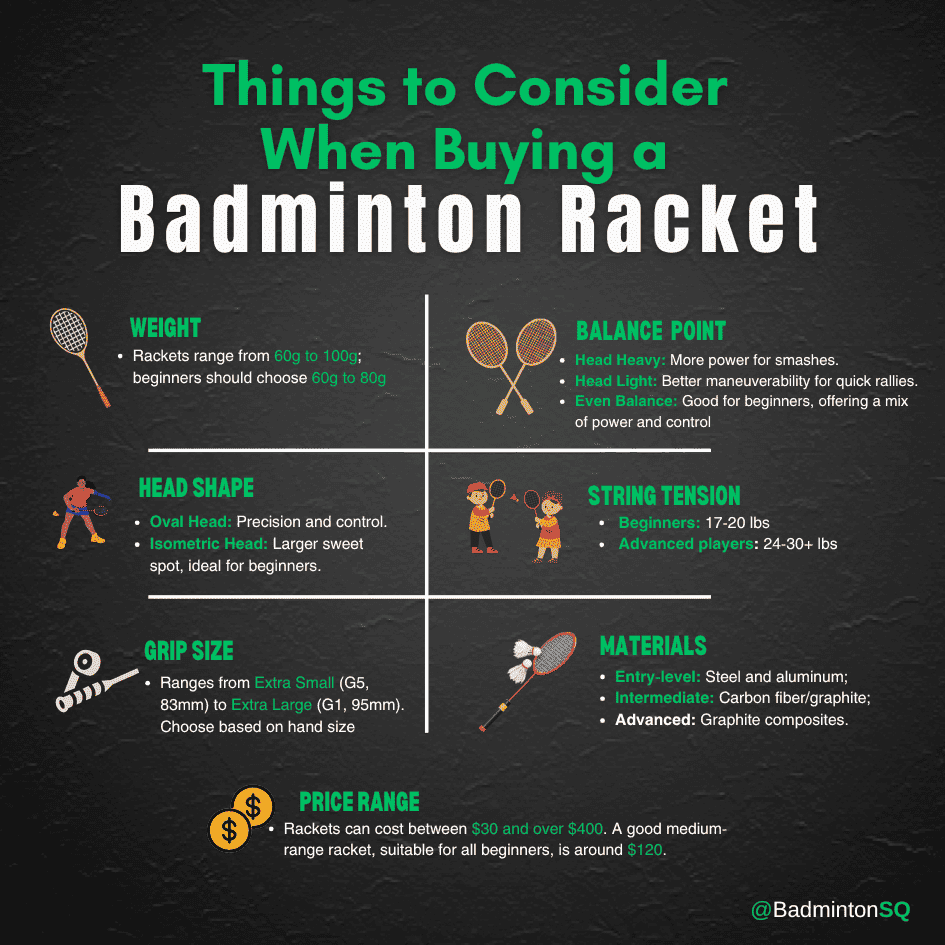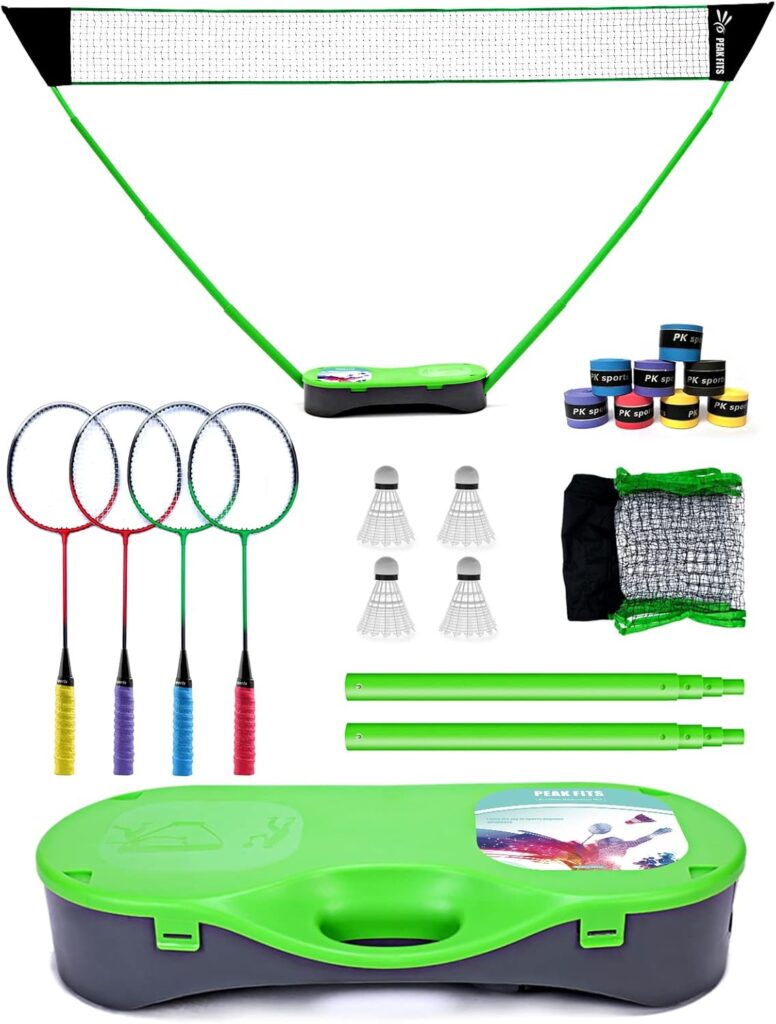Are you ready to buy your first badminton racket? Or do you want to upgrade your current equipment? Then, you must know what to look for in a racket.
Buying a Yonex racket just because it’s a good brand is not the right strategy here. Yonex has really good rackets, but if you buy the wrong type, your performance will be affected.
Select your badminton racket smartly. Here are all the things to look for when buying a badminton racket
- Weight
- Balance point
- Head shape
- Shaft stiffness
- String type
- String tension
- Grip size
- Material
- Price

Don’t worry; we will discuss all these in great detail in this article. Let’s go through how to check badminton racket quality by these points one by one.
Weight
Badminton rackets come in different sizes, usually ranging from 60 grams to 100 grams. There are rackets of 120 to 140 grams, but they are used only for wrist training by advanced players.
Beginners should start with rackets of lower weight around 60 to 80 grams. Intermediate and advanced players go a bit higher and use rackets of 80 to 100 grams. Until you get used to the weight don’t switch to a more weighted racket.
Based on weight, badminton rackets are given different grades. Each grade symbolizes rackets within a specific weight range. I have tabulated that below.
This grade is sometimes inscribed on the racket or written on the cover. If it’s not mentioned, ask the seller for equipment specifications.
| Weight Grade | Weight (in grams) |
| 8U | 59.9 or below |
| 7U | 60 to 69 |
| 6U or F (in Yonex) or W1 (in Li Ning) | 70 to 75 |
| 5U or W1 (in Li Ning) | 75 to 79 |
| 4U or W2 (in Li Ning) | 80 to 84 |
| 3U or W3 (in Li Ning) | 85 to 89 |
| 2U | 90 to 94 |
| U | 94 or above |

Balance Point
A balance point is not a physical point on the racket; it is how the weight of the racket is distributed throughout its body. In badminton, there are three types of rackets based on balance points.
- Head Heavy Rackets
- Head Light Rackets
- Even Balance Rackets
Head Heavy Rackets
The weight of the racket is more concentrated in the head part. That means the handle is lighter than the head.
These give more power to the shots. So, if playing smashes and drives is your thing, you will benefit from a head-heavy racket.
Head Light Rackets
The weight of the racket is more concentrated in the handle part. That means the head is lighter than the handle.
These give more maneuverability and flexibility on the court. So, if you are better at fast-paced rallies, you will benefit from a headlight racket.
Even Balance Rackets
Weight is not concentrated in any particular part of the racket; it is evenly spread throughout the entire equipment.
These rackets give you the best of the above two. You can expect some power and better maneuverability. It’s ideal for beginners until they figure out what they are best at.
Head Shape
The head of the racket is the circular part in which the strings are strung. This head comes in two shapes.
- Oval Head
- Isometric Head
The oval head, as the name suggests, is oval in shape – kind of an elongated circle along the vertical axis.
The isometric head is somewhat squarish in shape. It will be wider at the top than conventional oval rackets. The best part about these is the larger sweet spot.
Sweet spot: A region on the racket which gives the most effective shots if the shuttlecock makes contact with the racket in that region.
Because of the larger sweet spot, beginners prefer isometric rackets. On the other hand, oval rackets are more suitable for players who want precision and control in the game.
Shaft Stiffness
The shaft of the racket is the entire length of the handle. Shaft comes in three categories.
- Stiff
- Medium
- Flexible
The table below highlights the nature of each type of shaft and who can benefit the most from them.
| Flexibility Level | Nature of the Shaft | Best Use Cases |
| Stiff | The shaft doesn’t bend even with the application of force. | A stiff shaft gives you better control over your shots. A player who is physically capable of putting a lot of power in the swing should choose this type. Without power, you won’t be able to generate speed in your shots. |
| Medium | The shaft bends a little when force is applied with swift movement of the hand. | A medium shaft is comparatively easier to handle. It gives some extra whip power from its end, so you don’t have to put as much power as a stiff racket. It’s easier to control shots and attain power simultaneously. |
| Flexible | The shaft bends easily with a swinging movement. It has extra flexibility. | A flexible shaft is most suitable for players who have a hard time physically putting power in the shots. The flexibility of the racket does that for you. However, these shots with such rackets are less accurate due to the extra whip action from the shaft. |
String Type
Badminton strings can be categorized based on three factors – material, gauge, and feel of the string.
Material
Usually, three types of materials are used to make badminton racket strings.
- Nylon: Various compounds of nylon, including polymers with high intensity and heat resistance, are developed for the strings. These are the cheapest of all materials. They are also more durable.
- Synthetic gut: Compounds are created to replicate the structure and surface of the natural gut. These are a bit more expensive than nylon strings. But they also give better control.
- Natural gut: Traditional badminton strings are made from natural animal intestines. They provide better power and more control than any other material. However, they are the most expensive and require consistent maintenance. They are prone to attract bacteria and fungi, so you need to keep them clean at all times.
Gauge
Gauge is the thickness of the badminton strings. They typically have a diameter of 0.61 to 0.75 mm.
Strings of 0.68 mm or less are considered as thin strings, and those of 0.70 mm or more are considered as thick.
Thinner strings tend to break easily, but they help deliver more power in the shots. Thicker strings are more durable but provide less power.
Feel
Badminton strings are categorized into three types based on how their output feels like.
- Power Strings: They deliver maximum repulsion so players can achieve very high power. They are particularly suitable for attacking singles players, and rear-court doubles players.
- Control Strings: They are perfect for controlled shots because they are designed with a textured finish. They are particularly suitable for front-court doubles players and singles players who want more control in their shots.
- Durability Strings: Durable strings have thick diameters. They last longer than most strings. They are most used for hardcore training exercises where chances of wear and tear are maximum.
String Tension
String tension is how tight you wound the strings in the racket. Beginners should start with lower string tension and then increase it when they gain more control over their shots. Some players wound horizontal and vertical strings at different string tensions to get even better outcomes.
The following table shows various levels of string tensions.
| Skill Level | String Tension (in lbs) |
| Beginner | 17 to 20 |
| Intermediate | 20 to 24 |
| Advanced | 24 to 27 |
| Professional | 27 to 30+ |
Grip Size
Grip size the the size of the handle where you hold the racket. Usually there are five different size options. Select the one that fits best in your hands. If you have large hands, you will need a bigger grip and vice versa.
Here’s a table showing different grip sizes in badminton rackets. These are usually written on the racket’s shaft.
| Grip Size | Grip Size Notation | Size (in mm) |
| Extra Small | G5 | 83 |
| Small | G4 | 86 |
| Medium | G3 | 89 |
| Large | G2 | 92 |
| Extra Large | G1 | 95 |
Materials
- Entry-level badminton rackets are made of steel and aluminum. Steel rackets are the heaviest and most cost-effective. They are also very strong and durable.
- Aluminum rackets are a bit lighter and provide a bit more flexibility.
- Intermediate players opt for carbon fiber or graphite material. These are lightweight and easier to use.
- Advanced players invest in graphite and graphite composites because they come with technologies like nanomaterials.
Price
Badminton rackets are available for as low as $30 and could go up to more than $400. Usually, branded ones cost more around the range of $200 to $300.
But frankly, if you are just starting out, there’s no need to spend so much on the equipment. You could easily get an amazing racket in a medium price range. Casual players sometimes end up spending up to $1,000 a year on equipment. But that’s not absolutely necessary.
I always suggest players that think of a racket as a long-term investment. You could use it for at least 3 years. So, do the math, and you’ll see that you actually spend only a small amount per year on a racket. Only you have to pay it upfront.
Conclusion
Now you know how to select a badminton racket. Each of these points is very important. However, I’m emphasizing again that you don’t have to spend a fortune to get all the specs right. You can get really good rackets in your budget. You just have to look for them.
And don’t buy a racket by the book. Try a few different options. See what feels right. You could visit stores like Decathlon that let you try out the equipment. Those are best for getting the real feel. You could even ask the store assistants for recommendations.
Declaration: Some of the links in this article are affiliate links. I may earn a commission when you click and make a purchase from these links. You do not bear any extra cost by clicking on these links.
FAQs
How can you tell the quality of a badminton racket?
You can tell the quality of a badminton racket by looking at the material used for the body and string. You could get a better idea by feeling it in your hands. It should feel sturdy and comfortable to use.
Is 5U better than 4U?
5U rackets are usually used by beginners or female players. They are lightweight and easier to maneuver. On the other hand, 4U rackets give you more stability and power. But they are slightly heavier. Both have their own pros and cons. So, which is better totally depends on your individual needs.
Which badminton racket is best yonex or lining?
Both Lining and Yonex are reputable brands that manufacture badminton rackets. Both have different types of rackets with varied specifications. You can’t say one brand is better than another in any aspect. Both Yonex and Lining badminton rackets are the best with their own specification.
Are badminton rackets unisex?
Yes, badminton rackets are unisex. The rackets are made to fit players of both genders. They come in different weights, grip sizes and balances to accommodate individual preferences.
